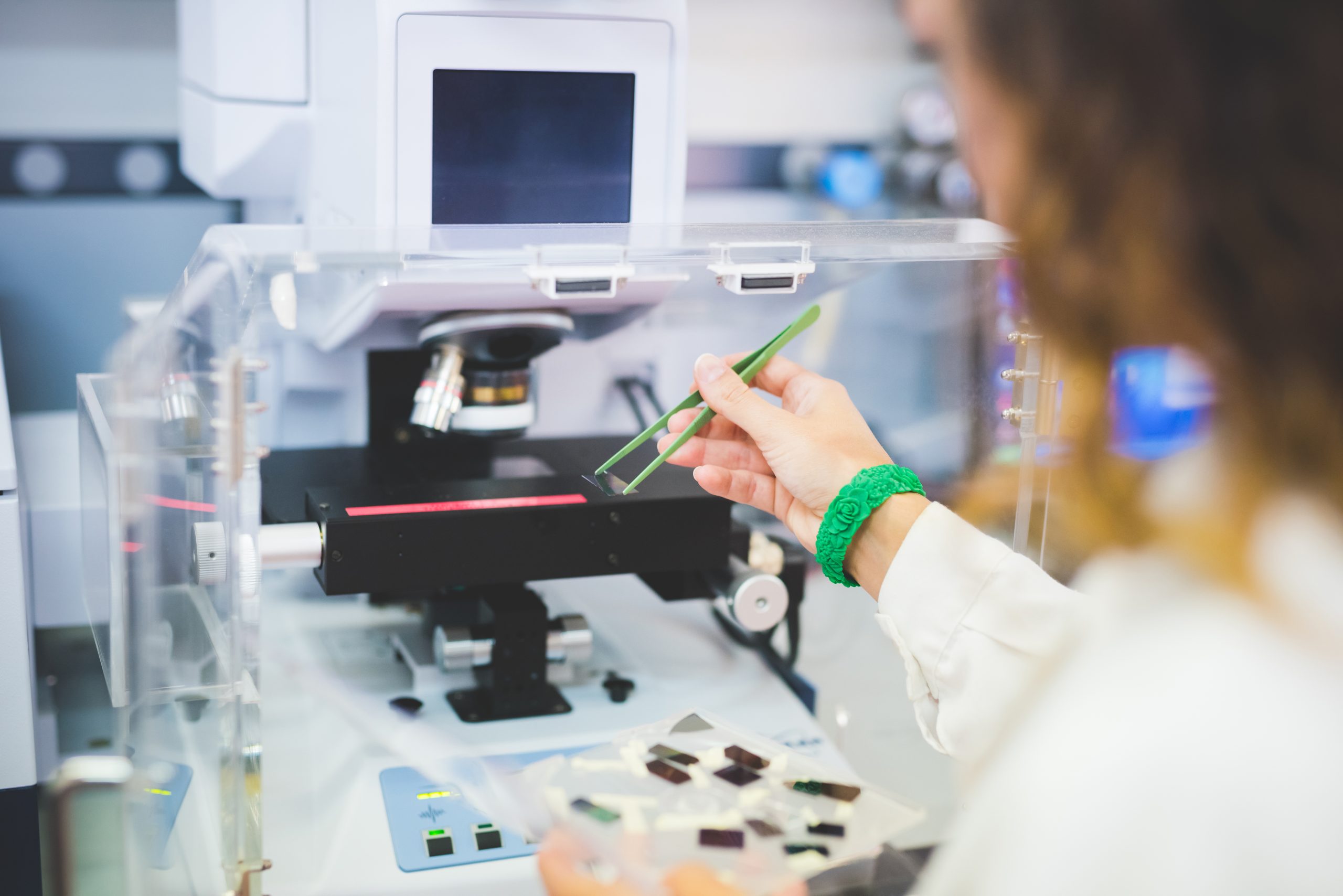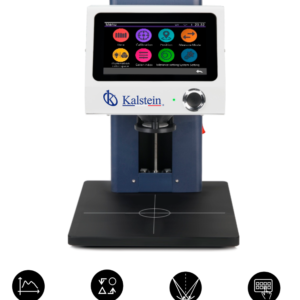Spectrophotometers
The spectrophotometer, invented in 1940 by Arnold J. Beckman and collaborators, was the Beckman company's greatest discovery. Before this, the chemical analysis was cumbersome and late. At first the technology of the equipment was experimental, which led to constant redesign, along the way the hydrogen lamp was invented, which offered improvements.
Over time it was automated and the speed of response improved, gradually incorporating control and detection systems that have resulted in the current spectrophotometer.

Types of laboratory spectrophotometers a Laboratory may need

Portable Benchtop Spectrophotometer
The importance of color as a physical characteristic and quality in food have a relevant role related to food additives. Consumers prefer attractive-looking products, and color is the first thing they evaluate. Usually, dyes are used to highlight the natural color of foods or to return the color lost in chemical processes carried out for their preservation. However, color in foods is not just an aesthetic attribute.
The dyes can be of natural or synthetic origin, legally they are considered an additive. These substances belong to the group of additives that present the greatest differences in the legislation of the countries. Its use could generate situations that harm the health of the consumer, since the product may not be as expected, or in the worst case be toxic. In general, in the legal regulations of each country there are different requirements on the type of dye, the concentration and the declaration of the ingredient in the labeling, it is also mandatory to characterize the food by the permisology associated with marketing.
Portable Spectrophotometer
Spectrophotometry is an analytical technique that allows determining the concentration of a compound in solution. It is based on the principle that molecules absorb electromagnetic radiation and in turn that the amount of light absorbed depends linearly on the concentration. A spectrophotometer is used to measure the amount of light absorbed by a solution.
That is, spectrophotometry refers to the measurement of relative amounts of light absorbed by a sample, as a function of wavelength. It is characterized by its accuracy, sensitivity and its applicability to molecules of different nature (pollutants, biomolecules, among others) and aggregation state (solid, liquid, gas).

At Kalstein, you can find the ideal spectrophotometers for your Laboratory

Grating Spectrophotometer YR05493
pectrometer is equipped with φ 8mm, φ 4mm, 1x3mm three measuring apertures, more adaptability, accurate...

Grating Spectrophotometer with 20mm Aperture
Kalstein launched new product YR05503 45/0 Grating Spectrophotometer with 20mm Aperture for Traffic Signs...

Double beam UV / VIS Spectrophotometer
Like establishing calibration curve, photometric measurement, quantitative measurement, spectral scanning...

Benchtop Color Haze Meter YR05479
benchtop color haze meter is developed by Kalstein independently with proprietary intellectual property. This...
Our Best Selling Spectrophotometers
YR01863//YR01865 series are wide screen double beam spectrophotometer.They adopt double beam long light path design to ensure the stability and accuracy; They are the best choice of high quality spectrophotometers.
Light path design: double beam
YR01863//YR01865 series double light path design can prevent circuit fluctuation and stray light to ensure stability of the instrument.
Powerful software functions
Multi functions like spectrum scanning, standard curve, kinetics, multi wavelength scanning, DNA/Protein testing can be operated directly on the pc.
Long path light design
YR01863//YR01865 series’ unique 520mm long light path design greatly improved resolution and the bandwidth can reach 0.5nm.
| Model | YR01863 | YR01864 | YR01865 |
| Optical System | Double Beam, 1200 Lines/mm Grating) | ||
| Wavelength Range | 190-1100nm | ||
| Bandwidth | 1.8nm | 1.0nm | 0.5, 1.0, 2.0, 4.0 nm |
| Wavelength Accuracy | ±0.1nm (D2 656.1nm), ±0.3nm @all range | ||
| Wavelength Repeatability | 0.1nm | ||
| Photometric Accuracy | ±0.2%T(0-100%T) | ||
| Photometric Repeatability | ≤0.1%T(0-100%T) | ||
| Photometric Range | -0.3-3A
0-200%T 0-9999C |
||
| Stability | ± 0.0003A/h @ 500nm | ||
| Baseline Flatness | ± 0.001A/h | ||
| Noise | ± 0.0005A | ||
| Stray Light | ≤0.03%T @ 220nm, 360nm | ||
| Data Output Port | USB | ||
| Printer Port | Parallel Port | ||
| Display | 320*240 Dots LCD | ||
| Lamps | Tungsten Lamp & Deuterium Lamp | ||
| Detector | Silicon Photodiode | ||
| Power Requirements | AC 220V/50Hz or AC 110V/60Hz | ||
| Dimension | 625*430*206mm | ||
| Weight | 32kg/32kg/34kg | ||

Spectrophotometer analysis for your Laboratory

Where is spectrophotometry applied?
Spectrophotometry is an analytical technique that allows determining the concentration of a compound in solution...

What is a Beam of Light in a Spectrophotometer?
The light beam of a spectrophotometer meets the projection of monochromatic luminescence to a sample...

What technology uses a spectrophotometer?
A spectrophotometer is a laboratory equipment used to measure the absorbance of a sample, as a function...

What is a UV-VIS spectrophotometer?
A spectrophotometer is a piece of equipment used to measure the absorbance of a sample, as a function of the...
Catalog of models Spectrophotometers on offer
-

Plus 45/0 8mm Spectrophotometer YR05505
-

Grating Spectrophotometer with 20mm Aperture YR05503
-

Grating Spectrophotometer with 8mm and 4mm Apertures YR05504
-

UV VIS Spectrophotometer- YR01852
-

Benchtop Spectrophotometer YR05478
-

Micro-Spectrophotometer YR06035
-

Non-contact spectrophotometer YR05481
-

Ultraviolet Visible UV / VIS Spectrophotometer – YR01854
Guides to Becoming an Expert Spectrophotometers
Benchtop spectrophotometer to measure color in food
The importance of color as a physical characteristic and quality in food have a relevant role related to food ...
Advantages of spectrophotometer for detecting impurities in food
Food that reaches the consumer has already gone through a journey from the producer, packaging, distribution and...
How is the Spectrophotometer used in the Cosmetic Industry?
The quality designation in the cosmetic industry, is composed of different variables. Among them, color is a very important...
Use of the Multiangle Spectrophotometer for the manufacture of nail polish
A spectrophotometer is an analytical instrument that allows measuring in a sample the properties of reflectance or light transmittance, at different wavelengths of the visible spectrum, from 400 mm to 700 mm...
Spectrophotometers operating
The spectrophotometer is an optical analysis instrument that allows projecting a beam of light through a sample and thus determining, identifying, and quantifying the absorbance or transmittance of energy. The amount of light absorbed or transmitted is proportional to the concentration of the material.
This difference is specific to certain species, so the equipment yields absorption spectra that are unique to each substance and are often used as a fingerprint. Spectrophotometric methods vary depending on the range of the working spectrum, they can be visible spectrum, UV and infrared.

Frequently Asked Questions about Spectrophotometers
How to know the prices of spectrophotometers?
To know the price of Spectrophotometers, we invite you to send us an email with your request through the contact form.
What are the delivery times of spectrophotometers?
- If the equipment of your interest is in stock or if it must be manufactured.
- The type of freight you have chosen, this may be; air or sea.
How to buy Spectrophotometers?
- By email: [email protected]
- By telephone: +33 (0) 1 78 95 87 02
- E-commerce: Via Kalstein's official website in your country.
How does the warranty work?
Can I request a quote online?
Of course, you can request a quote for the Kalstein team of your interest, directly from our official website. Once you have identified your preferred model, click HERE
